Table of Contents
Types of Potatoes
There are over 200 different varieties of potatoes that can be grown, but they all fit into the category of 1 of the 7 main types of potatoes.
Russet Potatoes
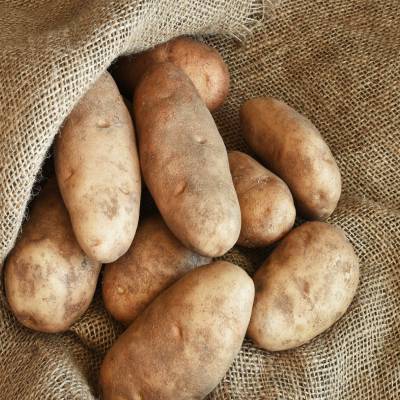
Russet Potatoes
Russet potatoes may be the most popular type of potato that is consumed. It is a great potato to be used in a variety of ways including mashed potatoes, baked potatoes, and french fries. It has a dry texture that is light and fluffy and a skin that is on the chewy side when cooked.
The flavor of russet potatoes is mild and earthy, which is why it works so well for a variety of dishes because russet potatoes can be seasoned any way that is desired.
Red Potatoes

Red Potatoes
Red potatoes are usually small in size and have a smooth red skin with white flesh. They are typically used in salads, soups, and steamed. Their flavor is subtly sweet and they have a creamy texture that is well liked by many.
White Potatoes
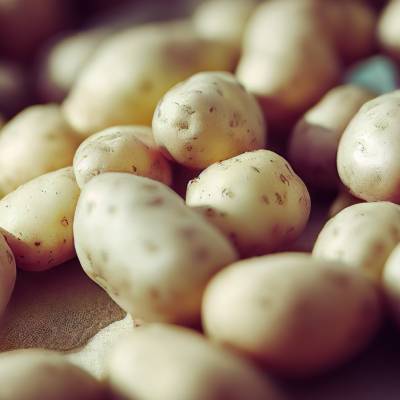
White Potatoes
White potatoes are very similar to red potatoes in that they are smaller in size and have a smooth skin. However, white potatoes will have a white skin with the same white flesh inside. Their texture is slightly creamy and dense with a thin and delicate skin.
Their subtly sweet flavor makes them great to be used in salads as well as mashed or pan fried.
Yellow Potatoes
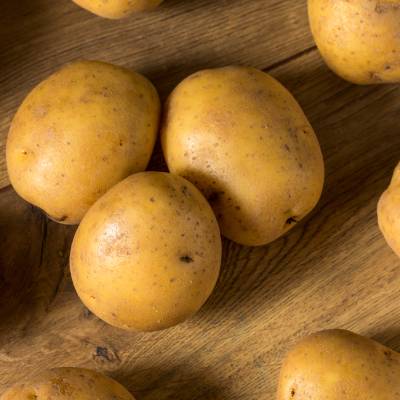
Yellow Potatoes
Yellow potatoes tend to be slightly larger in size with light tan skin and a flesh that is also tan to gold in color. It has a velvety and moist texture with a rich and buttery flavor, which is why yellow potatoes are great grilled, baked, mashed, or even in salads.
Purple Potatoes
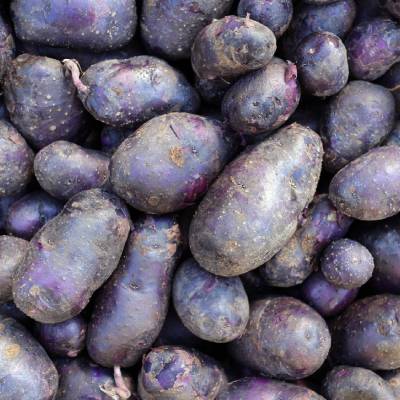
Purple Potatoes
Purple potatoes come in a variety of shapes, colors, and sizes. They can be small to medium in size, but vary in shape from oblong to fingerling. Purple potatoes can be anywhere in color from having deep purple, blue, or red skin and blue, purple, pink, or white flesh.
They have a moist and firm flesh with a nutty flavor that is great for roasting, salads, or putting on the grill.
Fingerling Potatoes
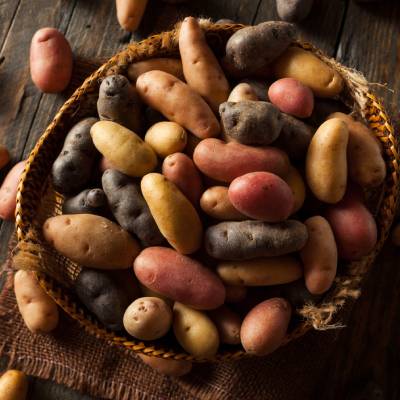
Fingerling Potatoes
Fingerling potatoes are some of the smallest potatoes you will see. They are typically only 2-4 inches and are typically oblong in shape. They will usually have purple, red, orange, or white skin and red orange, yellow, purple, or even white flesh that can sometimes have streaks of color within it.
They have a waxy and firm texture with a flavor that can be described as buttery, nutty, or earthy. Fingerling potatoes are perfect to pan fry, be thrown into a salad, or roasted.
Petite Potatoes
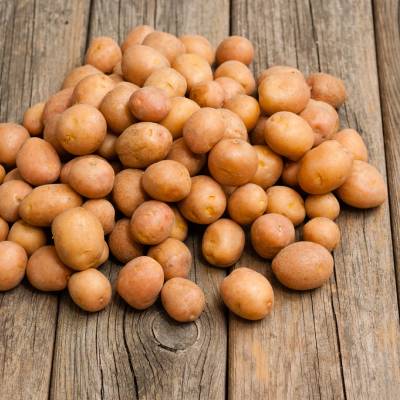
Petite Potatoes
Petite potatoes are even smaller than fingerling potatoes as they are typically bite sized. They can occasionally be called marble sized. They have the same skin, flesh, texture, and flavor as fingerling potatoes. The only true difference is their size.
Growing Potatoes
Potatoes are fairly easy plants to care for provided you give them the basics of what they need. They make a good plant for beginners and can be planted in the ground, in a pot, or even in a bag.
When to Plant Potatoes
Potatoes can be planted throughout the year, depending on the exact variety of potato that you are planting. For the most part, many people will plant in the Spring because the weather tends to be slightly nicer and the ground will not be hard from any frost which will make it easier to manage the planting of potatoes.
It can be a good idea to take a thermometer and check the temperature of your soil prior to planting. The closer your soil is to 50 degrees fahrenheit, the better it will be for the health of your potato plant.
How Long Does It Take to Grow Potatoes?
There are three different categories when it comes to how long potatoes will take to grow. There are potatoes that are considered early, midseason, and late varieties. They each have different lengths of time that it takes to reach full maturity.
Early season potatoes will have the shortest maturation timeline and can be grown and ready to harvest in around 90 days. These potatoes will usually be smaller varieties of potatoes and are great if you want a fast turnaround.
Midseason potatoes will take approximately 100 days to reach full maturity. Midseason potatoes are great for warmer weather climates and they tend to be the most common type of potato that is grown.
Late variety potatoes will take the longest to reach full maturity and it will typically take 110 to 120 days for them to reach full maturity. Late variety potatoes also do extremely well in warmer climates and can be planted later in the year.
Soil
Potatoes grow best in a good soil that is well draining. If the soil does not drain well and the potatoes are sitting in a lot of moisture, it can cause disease and rotting. The ideal pH for potato plants is around 6.0 to 6.5, but they can tolerate a slightly lower pH as well.
When growing potatoes, it is also best if the soil is loose. Soil that is too hard or compacted can create growth problems with potatoes and they may become misshapen. You can also add compost to the soil to enrich it with nutrients prior to planting your potatoes.
Sunlight
Although potato plants can still thrive in a variety of conditions, it is ideal if they have direct sunlight for at least 6 hours per day.
Hydration
Potato plants need approximately 1 to 2 inches of water per week whether that comes from watering or rainfall. If you live in a dry climate, you will need to be sure to provide the water yourself to keep your plant thriving and growing. However, if you are receiving a good amount of rain then you will not need to water your plant. You do not want to overwater because it can cause the potatoes to rot.
Hilling
As the potatoes grow, they will start nearing the surface of the soil. Once you begin to see them pushing through, it is a good idea to hill the dirt and soil in a mound over the potato as potatoes grow best in darkness.
Morning is the best time to hill the potato plants as this will be when they are at their tallest. You will want to hill the dirt so it is covering the base of the plant and the tubers. If the potatoes are exposed to sunlight for too long they will turn green and lose their flavor, which can ruin the crop.
Recent Articles

















